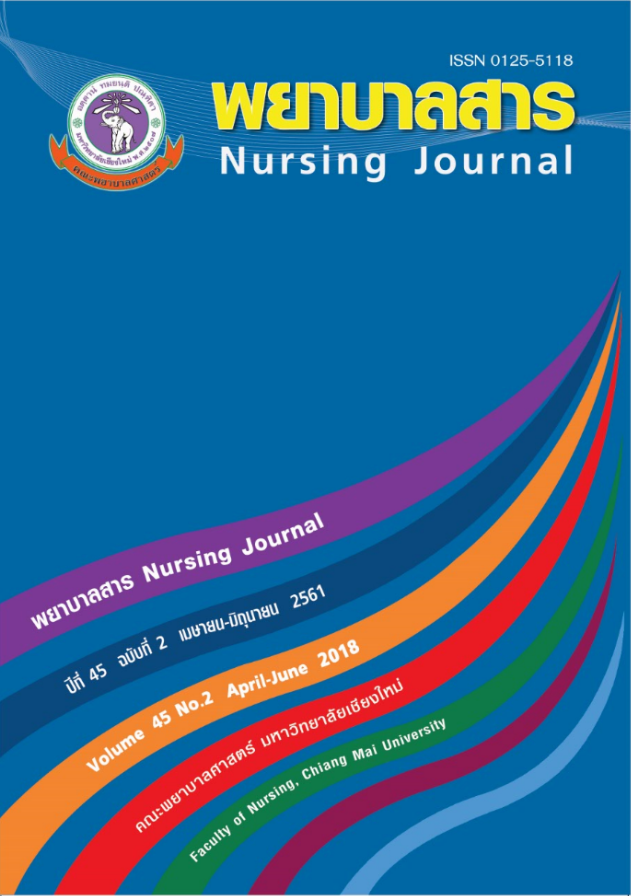Prevalence and Risk Factors of Low Back Pain Among School Teachers in Uttaradit and Phitsanulok Provinces
Keywords:
low back pain, school teachers, prevalence, risk factorsAbstract
Low back pain (LBP) is an important health problem because it impacts on work ability and leads to work absenteeism. The aim of this cross-sectional study was to determine the prevalence and risk factors of LBP among 125 school teachers in Uttaradit and Phitsanulok provinces. A self-reported questionnaire which had been confirmed the quality and composed of personal factors, behavioral factors, environment factors and work stress, and low back pain complaint was used for collecting the data. Data were analyzed by descriptive statistics and logistic regression.
Results showed that the 12 month prevalence of LBP among school teachers was 39.2%. Risk factors for LBP were previous diseases related to LBP (OR=5.5; 95%CI=1.15-26.77), back injuries from work (OR=2.5; 95%CI=1.00-6.21), and work stress from inadequacy of teaching materials and equipment (OR=2.9; 95%CI=0.97-8.66), respectively. School administrators can use the finding of this study to prevent LBP among school teachers.
References
ภานุมาศ พฤกษชาติ. (2556). ความเครียดของครูผู้ช่วยในสถานศึกษาจังหวัดตราด สังกัดสำนักงาน
เขตพื้นที่การศึกษามัธยมศึกษาเขต 17. (วิทยานิพนธ์การศึกษามหาบัณฑิต สาขาวิชาการบริหาร
การศึกษา). บัณฑิตวิทยาลัย, มหาวิทยาลัยบูรพา.
Abdulmonem, A., Hanan, A., Elaf, A., Haneen, T., & Jenan, A. (2014). The prevalence of musculoskeletal pain & its associated factors among female Saudi school teachers.
Pakistan Journal of Medical Sciences, 30(6), 1191-1196.
Al-Qahtani. W.A.R., Al-Faifi, I.S., Al-Garni, A.A.A., Al-Bakri, M.Z., Bajahlan, S.O., Deajim, S.A.D.,
Al-Oddadi, M., Asiri, A., & Mostafa, O.A. (2016). Magnitude and risk factors of low back
pain among Saudi teachers in Abha city, Saudi Arabia. Medical Journal of Cairo
University, 84(2), 87-92.
Balakrishnan, R., Chellappan, M.E., & Thenmozhi. (2016). Prevalence of low back pain and its
risk factors among secondary school teachers at Bentong, Pahang. International Journal
of Physical Education, Sports and Health, 3(2), 35-40.
Beyen, T.K., Mengestu, M. Y., & Zele, Y.T. (2013). Low back pain and associated factors
among teachers in Gondar Town, North Gondar, Amhara Region, Ethiopia.
Occupational Medicine & Health Affairs, 1(5), 1-8. Retrieved from
http://dx.doi.org/10.4172/2329-6879.1000127
Cardoso, J.P., Ribeiro, I.Q.B., Araujo, T. M., Carvalho, F.M., & Reis, E.J.F.B. (2009). Prevalence
of musculoskeletal pain among teachers. Revista Brasileira de Epidemiologia, 12(4),
1-10.
Cooper, C. L. (1983). Identifying stressors at work: recent research developments. Journal
of Psychosomatic Research, 27(5), 369-376.
Darwish, M. A. & Al-Zuhair, S.Z. (2013). Musculoskeletal pain disorders among secondary
school Saudi female teachers. Pain Research and Treatment, 1-7. Retrieved from
http://dx.doi.org/10.1155/2013/878570
Durmus, D. & Ilhanli, I. (2012). Are there work- related musculoskeletal problems among
Teachers in Samsun, Turkey? Journal of Back and Musculoskeletal Rehabilitation, 25,
5-12.
Engels, J.A., van der Gulden, Senden, T.F., & van’t Hof, B. (1996). Work related risk factors for
musculoskeletal complaints in the nursing profession: results of a questionnaire survey.
Occupational and Environmental Medicine, 53, 636-641.
Erick, P. & Smith, D. (2014). Low back pain among school teachers in Botswana, prevalence
and risk factors. BMC Musculoskeletal Disorders, 15, 359.
Green, L.W. & Kreuter, M.W. (1999). Health promotion planning: An educational and
ecological approach (3rded.). California: Mayfield.
Landry, M.D., Sudha, R.R., Christopher, S., Yvonne, G., & Elham, H. (2008). Prevalence and
risk factors associated with low back pain among health care providers in a Kuwait
hospital. Spine, 33(5), 539-545.
Mohammadi, G. (2013). Musculoskeletal complaints among high school teachers.
Journal of Musculoskeletal Research, 16(2). Retrieved from
http://doi.org/10.1142/s0218957713500103
Mohammadi, G. (2017). Prevalence of low back pain and associated risk factors among high
school teachers in Kerman, Iran. Journal of Musculoskeletal Research, 20(1).
Retrieved from http://doi.org/10.1142/s0218957717500051
Morewitz, S.J. (2006). Chronic diseases and health care: new trends in diabetes,
arthritis, osteoporosis, fibromyalgia, low back pain, cardiovascular disease and
cancer. The United States of America: Springer.
Samad, N. I. B., Abdullah, H., Moin, S., Tamrin, S.B.M., & Hashim, Z. (2010). Prevalence of low
back pain and its risk factors among school teachers. American Journal of Applied
Sciences, 7(5), 634-639.
Violante, F.S., Fiori, M., Fiorentini, C., Risi, A., Garagnani, G., Bonfiglioli, R., & Mattioli, S. (2004). Associations of psychosocial and individual factors with three different categories of back disorder among nursing staff. Journal of Occupational Health, 46, 100-108.
Yamane, T. (1973). Statistics: an introduction analysis (2nded.). New York: Harper & Row.
Yue, P., Liu, F., & Li, L. (2012). Neck/shoulder pain and low back pain among school teachers
in China, prevalence and risk factors. BMC Public Health, 12, 789.
Translated Thai References
Thitilertdecha, Pisit., Thongthiangdee, Benjaporn., Kaewnoppakhun, Saowapak., & Laoittihi, Poranee. (2012). Risk factors of low back pain among teachers and academic personals in 4 regions in Thailand: a cross-section study. Journal of Health Systems Research, 6(4),524-531.
Panumas Phunksachart. (2013). The stress of assistant teachers of schools in Trat province
under the Secondary Educational Service Area Office 17. Thesis of Master Degree in Education, Department of Educational Administration, Faculty of Education,
Burapha University.
Downloads
Published
How to Cite
Issue
Section
License
บทความที่ได้รับการตีพิมพ์เป็นลิขสิทธิ์ของวารสารพยาบาลสาร
ข้อความที่ปรากฏในบทความแต่ละเรื่องในวารสารวิชาการเล่มนี้เป็นความคิดเห็นส่วนตัวของผู้เขียนแต่ละท่านไม่เกี่ยวข้องกับมหาวิทยาลัยเชียงใหม่ และคณาจารย์ท่านอื่นๆในมหาวิทยาลัยฯ แต่อย่างใด ความรับผิดชอบองค์ประกอบทั้งหมดของบทความแต่ละเรื่องเป็นของผู้เขียนแต่ละท่าน หากมีความผิดพลาดใด ๆ ผู้เขียนแต่ละท่านจะรับผิดชอบบทความของตนเองแต่ผู้เดียว





